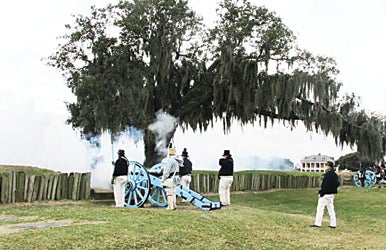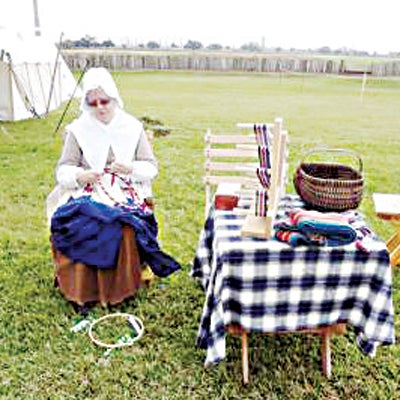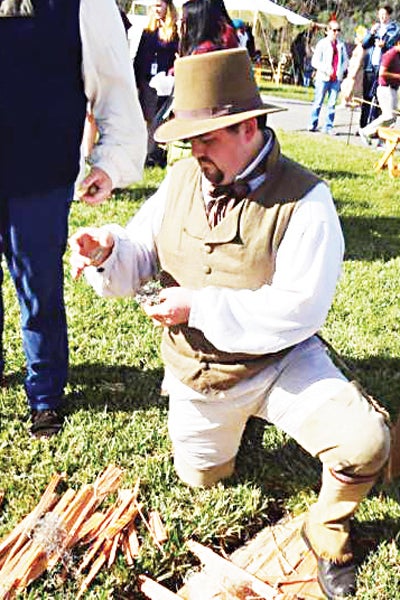East Tennessee Militia relives history in New Orleans
Published 10:39 am Monday, February 1, 2016
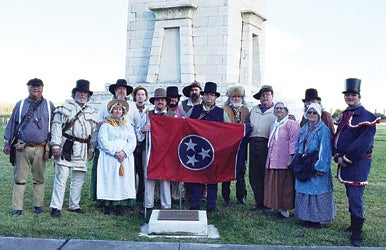
Contributed Photo
The East Tennessee Militia holds the Tennessee flag behind a plaque recognizing the significant role of the Tennessee Militia in holding off British forces.
Seventeen members of the First Regiment of the East Tennessee Militia recently participated in the reenactment of the Battle of New Orleans on its 201st anniversary at the Chalmette Battlefield in Louisiana, a battle which epitomized the status of America as liberated from the British. They passed the remainder of the weekend in character, cooking over fire pits, demonstrating weaponry, living in authentic tents, wearing handmade clothing and demonstrating early American skills, toys and cooking for visitors and schoolchildren.
Even though the treaty ending the War of 1812 was signed in 1814, the war was not over. British forces were still attempting to attack via passage along the Mississippi River at New Orleans.
The courage and cunning of Gen. Andrew Jackson, reenacted by Elizabethton’s own Grant Hardin, along with a hastily assembled company of regular soldiers, volunteer militia, freed men and privateers championed the well-trained and numerically superior British troops.
“I feel that we won our independence at Yorktown, but I think we confirmed it and established our reputation after the Battle of New Orleans,” said Hardin. “That let every other nation in the world know that they couldn’t walk all over this new town.”
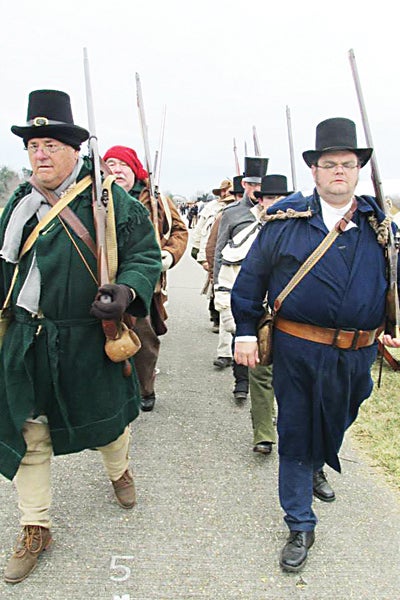
The First Regiment, along with historical reenactors from all over the South — totaling about 2,000 men — arrived on Jan. 6 to begin training for the reenactment of a night battle. They practiced elbow-to-elbow firing muskets in drills, and Hardin said no one even got a powder burn.
Friday night, Jan. 8, hundreds of militia assembled to relive this important scene from the making of America.
Hardin described the battle, saying 1,600 British soldiers were able to get over one of Jackson’s barriers and arrived at a planter’s home on the bayou.
“Their plans were to march up the Levee Road there, and to march early, because they thought Jackson didn’t have enough troops to stop them, and they were right,” said Hardin.
But, unexpectedly, the planter’s son climbed out a window and ran ahead of the army to Jackson, informed him of the invasion, and lied to the British about how many American soldiers awaited them. The British decided to set up camp and sent for reinforcements. Meanwhile, Jackson sent a gun boat down at dusk and opened fire on their camp, said Hardin.
“It was a fierce engagement in the dark, and they never tried to advance on them again without full force,” Hardin recalled.
All told, at the Battle of New Orleans the British army totaled more than 8,000 troops, Hardin said, while Jackson’s crew numbered about 5,000 and contained only two professional companies of American soldiers, 700 Choctaw natives, farmers, volunteers and others from all over the South.
“It was a very powerful army, but very nondescript,” said Hardin, adding he even had the pirate Jean Lafitte and his crew fighting with them. “Jackson couldn’t even understand how everyone talked that was fighting with him.”
The British competition was stiff, Hardin said, describing its composition of “trained, professional, hardened regular troops” that defeated Napoleon Bonaparte only two years earlier.
But the Americans had something the British did not: the leadership and strength of Jackson.
“Soldiers said if it hadn’t have been for Jackson’s personality, fire and build in the middle of it, they couldn’t have won,” said Hardin. “He didn’t watch from a distance with a spy glass; he was right in it.”
The Red Coats were defeated with numbers of wounded and dead at 2,241, far more than the assorted American crew with only 16 killed and 67 wounded, according to Hardin.
“If it hadn’t been for him and that nondescript army of civilians, America would have been under British control,” explained Hardin. “They rolled over armies in the North and headed to the South. We’re a free people depending on what happened down there.”
Aside from the critical role Jackson played in this American success, numerous soldiers from the Volunteer State showed to defend their homeland.
Brigadier General Nathaniel Taylor, who lived in the house on Sabine Hill, took approximately 1,000 volunteer soldiers with him, one of whom was Hardin’s ancestor.
“Jackson put everyone where he wanted them to guard the stone fort in Mobile, Alabama, and closing the border all the way to Pensacola, Florida, to make sure the Brits had to march on his line,” said Hardin. “His strength and courage held those men together when they defeated the greatest army on Earth.”
Friday morning, prior to the battle reenactment, Hardin, in his role as Jackson, gave an address to his soldiers, and the crew paraded and held an opening ceremony. Almost 2,500 school children were present to witness the historical event and to learn about early American life.
Tammy Markland, a first-time attendee with the First Regiment said they went to the French Quarter to participate in the Battle of New Orleans parade. Due to a delay, they found themselves meandering the streets in 18th century garb visiting such historic sites as Jackson Square, the Joan of Arc Statue, and Lafitte’s Blacksmith Shop and Bar (which the pirate LaFitte’s brother owned and used for smuggling. Opening in 1772, Lafitte’s Blacksmith Shop and Bar is the oldest bar in the United States.
A plaque at the Chalmette Battlefield reads: “The Tennessee Militia formed the backbone of the American line. Hailing from General Andrew Jackson’s home state, many were veterans of his victory over the Creek Indians at Horseshoe Bend. Led by Generals William Carroll and John Coffee, their arrival offered Jackson the reassuring presence of familiar, combat-proven soldiers. Jackson demonstrated his unwavering confidence in the Tennesseeans by positioning them at vulnerable points on the line. His foresight was rewarded on January 8, as the men from the Volunteer State secured the crucial left flank deep within the swamp and held firm in the center while receiving the full brunt of the British assault.”
For more information on the First Regiment, visit https://firstregimenteasttnmilitia.wordpress.com.
